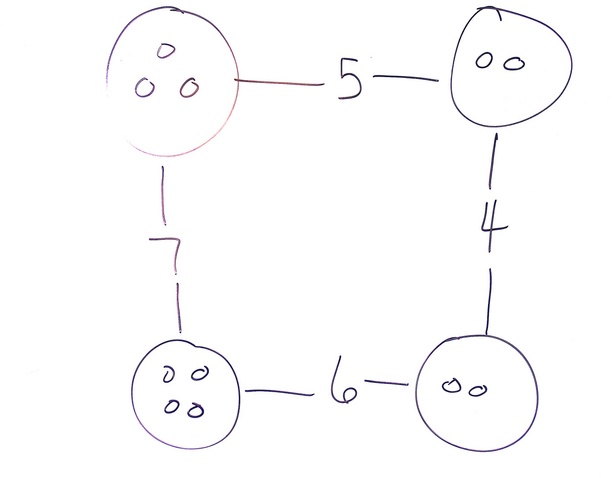A long time back, I was over at Lawrence’s house and Gail had a number puzzle up on the whiteboard that she was using with her homeschool consortium gradeschool math class.

For the students, I think Gail drew the circles with pebbles in them and the younglings had to count the pebbles and write the sums of the nodes into the edges.
For adults, it’s a lot more interesting to start with the numbered edges and fill in the vertices with numbers that make the edge sums work. It’s not hard; it’s just a little bit of a twisty way of thinking.
And you have to keep your vertices balanced enough that you don’t “overflow” an edge. For example, if you started with one pebble in the upper left, then you’d have to have four in the upper right, and then zero in the lower right, and let’s just say that zero pebbles isn’t permitted. Any solvable configuration will have multiple correct answers, but they’re constrained by overflow and underflow of all the edges of the graph.
Puzzle Ball
All of which made me think that this concept could make for an interesting LED puzzle ball. Make a dodecahedron (or a smaller regular polyhedron, or even a larger geodesic shape) with LEDs along the edges and LEDs and buttons (up/down?) at the vertices.
Start it up, the LEDs flash and wink all over the place as the controller randomizes the configuration. Use the buttons to adjust the numbers at the vertices (maybe blue LEDs) so that adjacent vertices add up to the number of LEDs on that edge. As each edge is “solved,” its LEDs change from red to green. Once you have all the edges green, you’re done.
Aesthetics
Seems like it’d be coolest as a “wireframe” polyhedron rather than a solid (or solid surface).
I think I’d prefer SMT LEDs over through-hole. 3mm through-hole if absolutely necessary.
I think I’d like the edge LEDs to be strips of nine that light up fairly symmetrically from the middle out, i.e. something like
----o---- ----o---- ---o-o--- ---oo---- --o-o-o-- ---ooo--- -o-o-o-o- or --oooo--- o-o-o-o-o the --ooooo-- -ooo-ooo- boring -oooooo-- -ooooooo- -ooooooo- oooo-oooo oooooooo- ooooooooo ooooooooo
I’d like the whole thing to be constructed from PCBs, no separate case. There’ll need to be room for microcontrollers and/or LED drivers. Maybe instead of having the PCBs on the face of the polyhedron, have them edgewise so the PCBs’ outer edges are the edges of the polyhedron. Internally, PCBs could be held together by jumper wires soldered together at the board edges and carrying the signaling bus from one board to another.
Gameplay
I still haven’t decided whether solving the puzzle ball would be fun or merely tedious.
I remember a particular game mode in the old Merlin where you’d press buttons and all the adjacent squares would invert state, with the goal being to get all the lights on or off. I always enjoyed that game, and the way local changes impacted neighboring cells, which impacted strategy for dealing with those neighbors. I would hope that the puzzle ball would be fun in much the same way.
If each edge has nine LEDs (1 – 9) and the game is played with non-modular addition, then the average number of lit LEDs per edge will be 5.5, making the average number of lit LEDs per vertex only 2.75 — that is, on average, only a very few numbers that need to be tried at each vertex. That doesn’t sound like a very interesting game. I could increase the number of LEDs per edge to 20ish, making the average edge sum 10ish, making the average vertex 5ish, which seems okay.
Or should there be ten LEDs per edge and operate in modular arithmetic? Would that make the puzzle too easy, having more correct solutions?